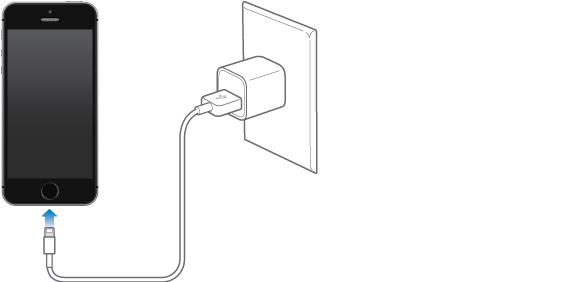iPhone has an internal, lithium-ion rechargeable battery. For more information about the battery—including tips for maximizing battery life—see www.apple.com/batteries.
WARNING: For important safety information about the battery and charging iPhone, see Important safety information.
Charge the battery. Connect iPhone to a power outlet using the included cable and USB power adapter.

Note: Connecting iPhone to a power outlet can start an iCloud backup or wireless iTunes syncing. See Back up iPhone and Sync with iTunes.
You can also charge the battery by connecting iPhone to your computer, which also allows you to sync iPhone with iTunes. See Sync with iTunes. Unless your keyboard has a high-power USB 2.0 or 3.0 port, you must connect iPhone to a USB 2.0 or 3.0 port on your computer.
Important: The iPhone battery may drain instead of charge, if iPhone is connected to a computer that’s turned off or is in sleep or standby mode.
The battery icon in the upper-right corner shows the battery level or charging status. To display the percentage of battery charge remaining, go to Settings > General > Usage. When syncing or using iPhone, it may take longer to charge the battery.

Important: If iPhone is very low on power, it may display an image of a nearly depleted battery, indicating that iPhone needs to charge for up to ten minutes before you can use it. If iPhone is extremely low on power, the display may be blank for up to two minutes before the low-battery image appears.
Rechargeable batteries have a limited number of charge cycles and may eventually need to be replaced. The iPhone battery isn’t user replaceable; it can be replaced only by an Apple Authorized Service Provider. See the Battery Replacement Program website.